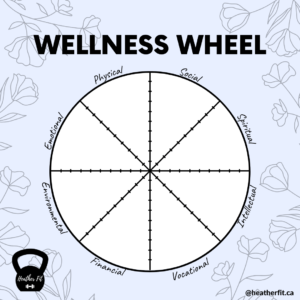When we think of our health, what often comes to mind is our physical health, such as nutrition and exercise. However, there are 8 dimensions of wellness that contribute to our health and well-being besides the physical elements alone (1).
Wellness
Wellness is a concept that looks at our health as an integration of our physical, mental and spiritual well-being (1). Specifically, wellness encompasses 8 interdependent domains, known as “The Dimensions of Wellness”. I like to call them, “The Roots of Wellness”. These dimensions all interact with each other and contribute to our overall health and well-being. In order to truly flourish, all dimensions of our wellness need our attention (1).

Flourishing is the product of the pursuit and engagement of an authentic life that brings inner joy and happiness through meeting goals, being connected with life passions, and relishing in accomplishments through the peaks and valleys of life.
Dr. Lynn Soots
Wellness is an Active Pursuit
Wellness is an active process where an individual practices healthy habits on a daily basis to attain better health outcomes. It’s about providing the appropriate amount of attention to all of the dimensions. However, the amount of attention required for each dimension will vary from person to person. The goal is to strive for a “personal harmony” that allows us to feel our best.
It’s important to note that not every aspect of our wellness is always under our control. This is because our wellness is significantly influenced by the physical, social and cultural environments in which we live.
Learn about the Eight Dimensions of Wellness below, as well as some strategies you can use to care for each dimension. In the comments at the end of the post, comment your favourite strategy you use you care for your wellness.
Want more ideas to care for your wellness? Check out my recent article, 5 Healthy Habits to Improve Your Wellbeing.
"The Roots of Wellness": The 8 Dimensions of Wellness

The Physical Dimension of Wellness
The physical dimension of wellness includes all of the behaviours that keep your body healthy (3). This can look like doing regular physical activity, eating a healthy diet, and getting enough rest/sleep. Other examples include managing stress, illness & chronic health conditions, avoiding harmful habits, and having self-care/hygiene (2, 3, 4).
Caring for our physical health also means we recognize and care for ourselves when we are not physically well, and understand how our behaviour influences optimum physical wellness (2).
Examples:
- Getting regular exercise
- Eating nutritious foods
- Maintaining a regular sleep routine
- Getting regular check-ups with your doctor & seeking medical care when appropriate
- Maintaining personal hygiene
- Managing stress to an optimal level
- Avoiding/limiting harmful substances (e.g., alcohol, cigarettes, and other substances)
- Practicing safe sex

The Emotional Dimension of Wellness
The emotional domain of wellness is about being able to recognize, accept, process, and take responsibility for your feelings. This includes being able to share both positive and negative feelings in appropriate and productive ways. It also includes recognizing, considering, and responding to the feelings of other people and animals (2).
Taking care of our emotional wellness allows us to build resiliency to work through life’s challenges, respond to stress, and overcome setbacks.
Examples:
- Knowing your personal values
- Being able to experience and express a wide range of emotions appropriately (e.g., anger, sadness, joy, appreciation, etc.)
- Developing positive self-esteem
- Having skills and resources to help you handle stress and life’s challenges
- Exploring and clarifying your own sexual identity

The Social Dimension of Wellness
The social dimension of wellness is having a sense of connectedness and belonging (6). It involves relating and connecting with other people and establishing/maintaining healthy relationships with others (5).
Caring for our social wellness can include getting involved in our community, spending time with other people, being genuine and authentic with others, and setting healthy boundaries (6). Having good social wellness allows us to initiate good communication with others, develop healthy relationships, and build better communities (5).
Examples:
- Cultivating healthy relationships with others
- Developing friendships and intimate relationships
- Getting involved, and/or contribute to your community
- Communicating your thoughts, feelings, and ideas with others
- Showing respect to other people and cultures
- Practicing good communication skills
- Caring for others & letting others care for you

The Spiritual Dimension of Wellness
The spiritual dimension of wellness provides meaning and direction to our lives through a guiding set of beliefs, faith, values, ethics, and/or moral principles (2). It involves establishing peace and harmony in our lives by helping us understand our values and purpose in life.
Spiritual wellness also includes developing characteristics such as compassion, forgiveness, altruism, optimism, and happiness. These characteristics can help us find hope, purpose, and meaning in our experiences (2, 6).
Practicing spiritual wellness can look like participating in self-reflection, meditation, prayer, or even spending time in nature (6).
Examples:
- Engaging in self-reflection, meditation, and/or prayer
- Spending time in nature
- Practicing self-compassion and compassion for others
- Participating in activities that are consistent with your beliefs and values (1)
- Contributing to the greater good

The Intellectual Dimension of Wellness
The intellectual domain of wellness includes recognizing our creative abilities, knowledge, and skills, and finding ways to utilize, expand, and share them with others (4). It also includes being able to recognize biases, helpful/unhelpful thinking, and managing inner dialogue and negative thoughts (2).
Ways to care for our intellectual wellness can include engaging in creative pursuits, exercising critical thinking skills, and participating in thoughtful discussions with others (3, 4).
This allows us to expand our knowledge and skills, participate in lifelong learning, and share these insights with others.
Examples:
- Using your creative abilities
- Exercising critical thinking skills
- Having a growth mindset
- Being curious
- Learning new skills & exploring new ideas
- Challenging yourself mentally (e.g., puzzles, learning new topics/skills)

The Occupational Dimension of Wellness
The occupational/vocational dimension of wellness is the ability to balance life with a satisfying vocation that is consistent with our values, skills, goals, and lifestyle (1, 2). This can also include volunteering and engaging in hobbies/interests that provide fulfillment, meaning, and purpose.
Ways to care for our occupational/vocational wellness include maintaining a work-life balance and exploring opportunities that allow us to develop & share our passions, skills, and talents.
Taking care of our occupational wellness helps us feel a sense of purpose and contribution to our community.
Examples:
- Choosing a career that fits your values and suits your personality, interests, and talents
- Participating in activities that give us a sense of purpose and meaning
- Being open to new opportunities, such as learning new skills
- Identifying and managing workplace stress and practicing conflict resolution

The Financial Dimension of Wellness
The financial dimension of wellness is about being able to meet your current and ongoing financial needs and feeling secure about your financial future. This includes balancing your needs and wants to achieve your financial goals. Additionally, it’s about engaging in behavour choices to ensure you have adequate income, savings, and investments for your needs (2).
Taking care of our financial wellness can help us manage household expenses, be prepared for times of financial uncertainty, be able to afford our wants/needs, and help secure our financial future. It can also give us the capacity to make contributions that support others (e.g., donating to a charity) (2).
Examples:
- Creating and managing short and long-term financial goals
- Following a budget and developing cost-savings skills
- Living within your means and avoiding unnecessary debts
- Paying bills on time
- Having savings and a plan for emergencies
- Saving and investing for retirement
- Seeking the appropriate financial help and resources, when needed

The Environmental Dimension of Wellness
The environmental dimension of wellness includes having respect for nature and all species living on the planet, as well as occupying environments that support well-being (7, 8).
This includes practicing daily habits that promote a healthy environment such as reducing waste, conserving energy, using active transportation, and recycling. Additionally, having access to green spaces and clean drinking water, feeling safe in our communities, and occupying pleasant and stimulating environments have profound effects on our environmental well-being. Although we are not able to control all of our environments, we can take small steps within our control to promote positive and safe spaces.
Developing your environmental consciousness can help you become aware of how your habits influence the environment, as well as how the environment can influence your well-being.
Examples:
- Understanding how your social, natural, and built environments affect your health and well-being
- Becoming aware of the current state of the planet
- Demonstrating commitment to a healthy planet and advocating for healthy and safe communities
- Reducing waste and conserving energy
- Recycling, when possible
- Spending time outdoors or in nature
- Getting connected and involved in your community
Wellness is about Balance
 As mentioned earlier, wellness is about giving the appropriate amount of attention to each of the domains, and this amount will vary from person-to-person and depending on the context. What’s important is finding the right balance for yourself, where you are able to function at your best.
As mentioned earlier, wellness is about giving the appropriate amount of attention to each of the domains, and this amount will vary from person-to-person and depending on the context. What’s important is finding the right balance for yourself, where you are able to function at your best.
To help you determine which areas to focus on, a great tool is using a wellness wheel. A wellness wheel allows you to rate how you feel you are doing for each domain of wellness on a scale from 1 to 10 – a lower number indicating an area you feel needs nourishment and attention. You can also use your wellness wheel to brainstorm strategies to care for each domain.
Once you have determined the areas of wellness that need attention, focus in on only one or two healthy habits to implement. Remember, it’s not about doing everything all at once, but it’s about slowly incorporating healthier habits into our daily lives. To avoid overwhelm and set yourself up for greater success, start with only one or two habits. As these habits get easier, continue to add in new habits over time.
You’ve got this!
I hope you found this article helpful. If you want more tips & tricks, check out the related blog posts below, follow my Instagram & subscribe to my YouTube channel!
xoxo,
Heather
Related Blog Posts
References:
- https://www.ncbi.nlm.nih.gov/pmc/articles/PMC5508938/
- https://uwaterloo.ca/engineering-wellness-program/nine-dimensions-wellness
- Powers, S. K., & Dodd, S. L. (2021). Total Fitness and Wellness (8th ed.). Pearson Education.
- https://jflowershealth.com/8-dimensions-of-wellness/
- https://www.uwsp.edu/health/Pages/about/7DimensionsWellness.aspx
- https://www.bbhcsd.org/DimensionsofWellness.aspx
- https://www.lifeofwellness.ca/8-dimensions-of-wellness/environmental-wellness/
- https://www.northwestern.edu/wellness/8-dimensions/environmental-wellness.html





One Response
To the heatherfit.ca admin, Your posts are always on point.